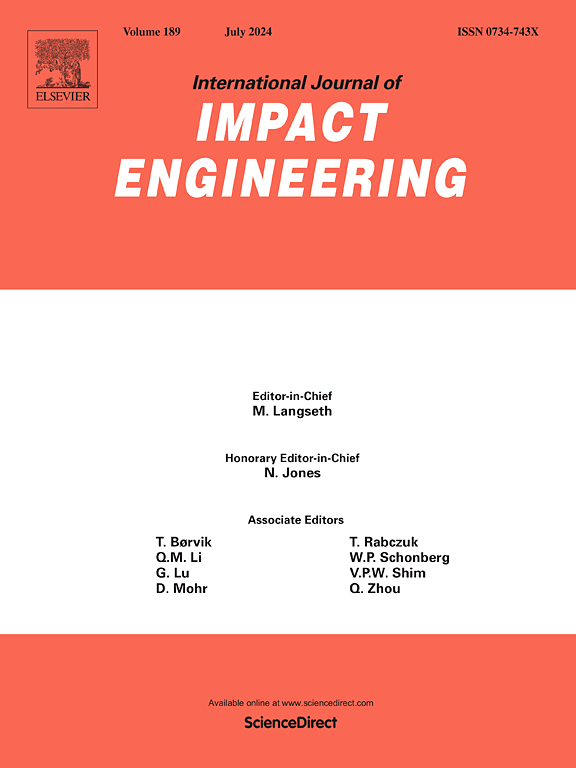Strain rate sensitivity of rotating-square auxetic metamaterials
IF 5.1
2区 工程技术
Q1 ENGINEERING, MECHANICAL
International Journal of Impact Engineering
Pub Date : 2024-09-19
DOI:10.1016/j.ijimpeng.2024.105128
引用次数: 0
Abstract
This study provides an in-depth analysis of the mechanical behavior of rotating-square auxetic structures under various strain rates. The structures are fabricated using stereolithography additive manufacturing with a flexible resin. Mechanical tests performed on structures include quasi-static, intermediate, and high strain rate compression tests, supplemented by high-speed optical imaging and two-dimensional digital image correlation analyses. In quasi-static conditions (5 × 10–3 s-1), multiscale measurements reveal the correlation between local and global strains. It is shown that cell hinges play a significant role in structural deformation and load-bearing capacity. In drop tower impact conditions (intermediate strain rate of ca. 200 s-1), the auxetic structures display significant strain rate hardening compared to loading at quasi-static rates. The thin-hinge structures maintain a Poisson's ratio of approximately -0.8, showing higher auxeticity than slow-rate compression tests. High strain rate conditions (ca. 2000s-1) activate additional deformation mechanisms, including a delayed state of equilibrium exemplified by a heterogeneous distribution of lateral strains, possibly due to stress wave interactions and inertial stresses. The study further reveals nonlinear correlations between Poisson's ratio, strain, and strain rate, indicating reduced auxeticity at higher strain rates. These observations are discussed in terms of complex wave interactions and the strain rate hardening characteristics of the base polymer.
旋转方形辅助超材料的应变速率敏感性
本研究深入分析了旋转方形辅助结构在各种应变速率下的机械行为。这些结构是用柔性树脂通过立体光刻增材制造而成的。对结构进行的机械测试包括准静态、中间和高应变率压缩测试,并辅以高速光学成像和二维数字图像相关分析。在准静态条件下(5 × 10-3 s-1),多尺度测量揭示了局部和整体应变之间的相关性。结果表明,电池铰链在结构变形和承载能力方面起着重要作用。在落塔冲击条件下(中间应变速率约为 200 s-1),与准静态速率加载相比,辅助应变结构显示出显著的应变速率硬化。薄铰链结构的泊松比约为-0.8,显示出比慢速压缩试验更高的辅助性。高应变速率条件(约 2000s-1 )激活了额外的变形机制,包括可能由于应力波相互作用和惯性应力造成的侧向应变异质分布所体现的延迟平衡状态。研究进一步揭示了泊松比、应变和应变速率之间的非线性相关性,表明在较高应变速率下的辅助性降低。这些观察结果将根据复杂的波相互作用和基体聚合物的应变速率硬化特性进行讨论。
本文章由计算机程序翻译,如有差异,请以英文原文为准。
求助全文
约1分钟内获得全文
求助全文
来源期刊

International Journal of Impact Engineering
工程技术-工程:机械
CiteScore
8.70
自引率
13.70%
发文量
241
审稿时长
52 days
期刊介绍:
The International Journal of Impact Engineering, established in 1983 publishes original research findings related to the response of structures, components and materials subjected to impact, blast and high-rate loading. Areas relevant to the journal encompass the following general topics and those associated with them:
-Behaviour and failure of structures and materials under impact and blast loading
-Systems for protection and absorption of impact and blast loading
-Terminal ballistics
-Dynamic behaviour and failure of materials including plasticity and fracture
-Stress waves
-Structural crashworthiness
-High-rate mechanical and forming processes
-Impact, blast and high-rate loading/measurement techniques and their applications
 求助内容:
求助内容: 应助结果提醒方式:
应助结果提醒方式:


